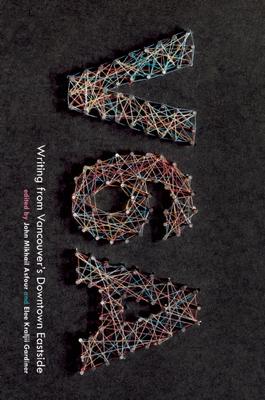V6A Book Review
Book Review
V6A: Writing from Vancouver’s Downtown Eastside has strange potency
By Jennifer Croll, April 18, 2012
 V6A – Writing from Vancouver’s Downtown Eastside
V6A – Writing from Vancouver’s Downtown Eastside
Edited by John Mikhail Asfour and Elee Kraljii Gardiner.
Arsenal Pulp, 150 pp, softcover
Anthologies often try to capture the best writing of a particular time or place—America in the 20th century, that sort of thing. V6A takes on an especially challenging time and place: Vancouver’s Downtown Eastside in the present day (and recent past). Its aim is to sketch a clear, sympathetic picture of the real DTES, a contrast to the nightmarish, one-dimensional version we see on the 11 p.m. news. And it achieves its aims admirably, relying on the eclectic voices of the people who live, work, and pass through the neighbourhood.
V6A’s editors, Elee Kraljii Gardiner and poet John Mikhail Asfour, didn’t specify a theme when soliciting works for the collection, but most of the fiction, poetry, and essays by the 32 writers depict the neighbourhood directly—though the perspectives are dizzyingly varied. And while you’ll recognize some prominent names in the table of contents, many of the writers in V6A are previously unpublished or else got their start through Thursdays Writing Collective, a weekly workshop at the Carnegie Centre facilitated by Gardiner. It’s not always possible to tell who’s new to publishing and who’s a seasoned vet—but sometimes it is. In my opinion, the contrast between the “public” writers and the “private” ones is an interesting aspect of the book. The more polished writing often imbues the rougher stuff with a strange potency.
The writing in V6A covers a lot of ground: religion, Chinese culture, prostitution, addiction, mental illness, loneliness, art, and black history, among other things. Some standouts: Don Macdonald’s story (originally published in Megaphone and told in a voice full of spitting fury and humour) about squatting in Pacific Spirit Park under the observation of a coyote; Michael Turner’s melancholy story of bohemian lovers in an apartment overlooking Oppenheimer Park; Madeleine Thien’s tale of losing religion and finding culture in Chinatown; Wayde Compton’s personally inflected history of Hogan’s Alley. But the book’s strength comes from the indelible image the stories and poems leave when experienced as a whole; together, they present a neighbourhood that, despite its problems, is very much alive.